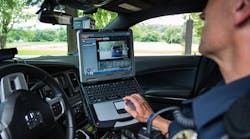Panasonic System Communications Company of North America announced its next generation Arbitrator BWC (body-worn camera) and enhanced Unified Evidence Management System. Designed and built based on direct feedback from law enforcement organizations across the country, the Arbitrator BWC features 720p HD video resolution and a 130° wide camera angle — capturing high-quality video and providing unbiased evidence of all officer interactions.
When integrated with Panasonic’s Arbitrator 360° HD in-car video systems, the new body-worn camera solution offers law enforcement agencies the industry’s most complete and cost-effective platform for mobile video evidence capture and management. The Arbitrator BWC can offload seamlessly via Wi-Fi and other methods to Panasonic’s Unified Evidence Management System, which allows officers to easily and securely manage all video evidence — including in-car, body-worn and fixed surveillance video — using a single, unified platform with flexible storage options.
Industry-Leading Camera Hardware and Rugged Design
In a 2014 study1 by VDC Research, 62% of public safety respondents said they were evaluating or planning to deploy wearable devices. As video evidence capture is becoming a standard for law enforcement agencies, the Arbitrator BWC is designed to provide officers with indisputable, courtroom-ready evidence, promote streamlined adjudication and strengthen community relations while adhering to local and federal regulations.
Featuring HD video resolution, digital image stabilization and low-light capabilities, the Arbitrator BWC is able to clearly capture evidence in virtually any environment, day or night. Its rugged and water-resistant design makes the body-worn camera reliable when exposed to dust, drops, humidity and other environmental conditions officers may encounter. Weighing only 4.6 ounces, the Arbitrator BWC’s lightweight, purpose-built design offers multiple mounting options to provide officers with a flexible system to meet their preferences. Full shift battery life (12 hours stand-by) guarantees full support on the job.
Responding to officer requests for easy operation in the field, the Arbitrator features 1-touch recording and is capable of pre- and post-event recording to ensure all interactions during an incident are captured. It stores evidence on secure digital media, and officers can easily classify video with a single button. With built-in GPS, it automatically records important metadata including location, time and date, and officer ID.
For alternative mounting options, an optional second camera is available with the same wide field-of-view as the main camera.
The Arbitrator BWC system provides agencies with flexible video file offload options including direct offload via Wi-Fi, USB or multi-bay docking stations. The systems offer integrated operation with Arbitrator 360° HD in-car video systems, and officers also have the option to view video in the field prior to offload using their tablets, with smartphone-viewing capabilities coming later this year.
Scalable, Flexible and Cost-Effective Video Management
The Panasonic Arbitrator BWC ships with Panasonic’s Unified Evidence Management System (UEMS), which allows agencies to efficiently and cost-effectively manage all video evidence using a single, unified system. The integrated platform is able to securely manage and retrieve all digital video evidence from Arbitrator 360° in-car systems, body-worn cameras, fixed surveillance video, photos and other types of video evidence data through a single platform. This enables agencies to significantly reduce time and costs related to offloading and managing data, as well as to reduce training, maintenance and IT support workload requirements.
Compatible with on-premises, cloud, hybrid and other archival systems for video storage, the Unified Evidence Management System is the industry’s most flexible and comprehensive option for law enforcement agencies to take advantage of video evidence, while maintaining security, chain of custody, and compliance requirements. This gives agencies the option to utilize the storage option that is most cost-effective for them, and to store all their video evidence in a uniform manner.








